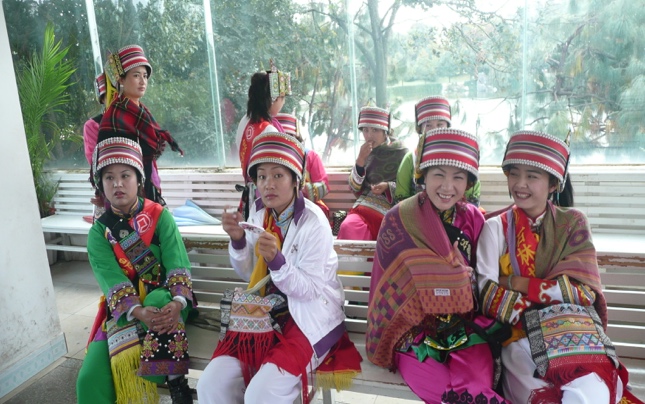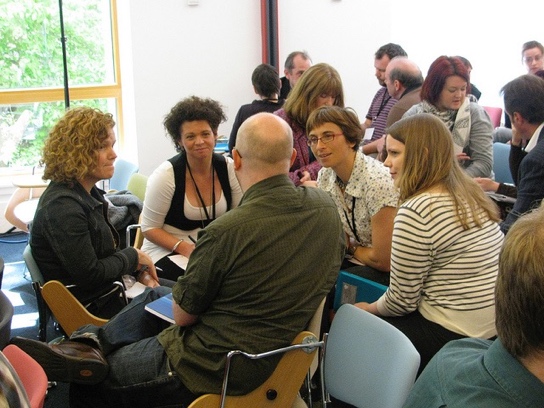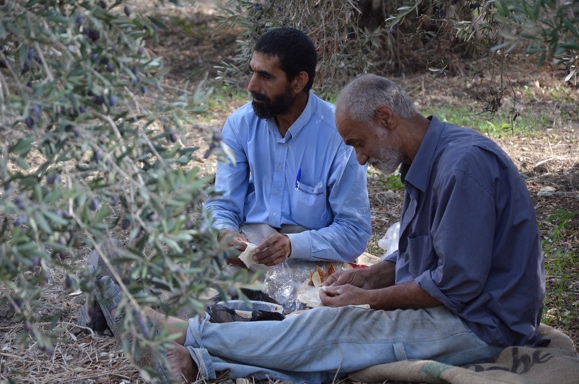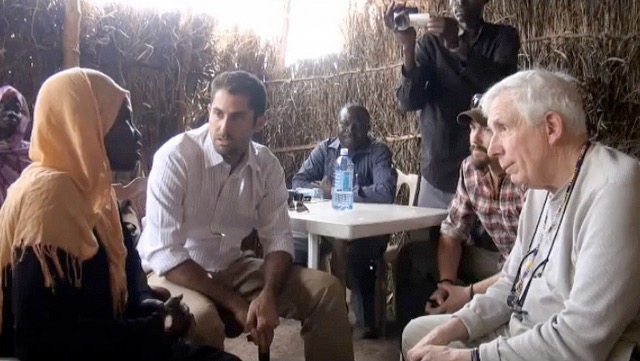1.2 Cultures under study and in the media
Intercultural Communication as an academic discipline
There are a variety of approaches to study and research intercultural communication (see Leeds-Hurwitz, 2010; Rogers & Hart, 2002). As an academic discipline, it is often traced back to anthropologist Edward T. Hall and his book The Silent Language (1959). Hall was above all concerned with creating greater cultural awareness among employees of the US Department of State. He was striving to improve the ability of US technicians and diplomats to interact effectively with their foreign counterparts. Given that perspective, his approach was understandably more practical than theory-based. That pragmatism continues to be important in the field, as a central goal is to provide individuals with practical information that can be used in everyday encounters (Rogers & Steinfatt, 1999).
Much of the early development of intercultural communication occurred in North America, and North American scholars represented the principal contributors to scholarly activity in intercultural communication through most of the 20th century. However, beginning in the 1990s, the field became increasingly internationalized. European scholars have contributed important new insights and approaches to intercultural communication (Byram, 1997; Holliday, 2010; Hua, 2013; Spencer-Oatey & Franklin, 2009), as have Australian and New Zealand scholars (Piller, 2017; Schirato & Yell, 2002). These scholars tend to focus more centrally on language issues than is the case for IC research in North America.
Through the contributions of researchers from Africa, China, Latin America, and India, there has been a growing recognition that Western approaches to intercultural communication need to be supplemented – and in some cases corrected – through the different life experiences, backgrounds, and perspectives offered by non-Western scholars. One example is the anthropocosmic perspective presented in a recent Chinese textbook on intercultural communication (Jia & Li, 2019), which is based on the concepts of dao (道, “the path”, the way to enlightenment through cosmic harmony) and ren (仁, “benevolence”, empathy and responsibility for fellow humans). There have been in recent years more calls for indigenous perspectives on intercultural communication (Miike, 2007). Particularly welcome would be more insights from African scholars (Miller, 2005). In the latter part of the 20th century, there has been considerable interest in critical intercultural communication, which views intercultural communication within the context of power structures (see Jackson, 2010; Piller, 2017). That perspective will inform much of the discussion of IC in this textbook.
Since Hall’s time, a great variety of disciplines have contributed to the field, including applied linguistics, business communication, social psychology, behavioral economics, and international studies. In fact, intercultural communication is taught within a variety of academic units. Given the practical usefulness of easing communication among those representing different cultures and languages, it is logical that intercultural communication figures prominently in areas where such interactions are common and expected. In many countries, that will include tourism, medical care, and/or education. In the US, intercultural communication is taught most commonly within programs in communication studies, while in other Anglophone countries, it is considered a subdivision of applied linguistics. Professional organizations often bring together scholars from a variety of disciplines. Indeed, that is one of the enriching characteristics of the field, that it draws on knowledge and experience representing many different academic fields. This textbook will incorporate aspects of research in intercultural communication as represented in a variety of disciplines. The disciplines use different research methodologies, have differing goals, and address issues from a variety of perspectives. Some use primarily quantitative data, others are more qualitatively oriented. In the end, these different approaches complement each other and together provide a more complete picture then would reliance on a single discipline (see Kotthoff & Spencer-Oatey, 2007).
What it means to be a confident intercultural communicator differs depending on the disciplinary orientation. However, as an overall set of common denominators, we might break down the competencies in the following categories, following the rubric on intercultural knowledge and competence from the Association of American Colleges and Universities (Rhodes, 2010):
|
Knowledge |
Skills |
Attitudes |
|---|---|---|
|
Cultural self-awareness |
Empathy |
Curiosity |
|
Knowledge of cultural worldview frameworks |
Verbal and nonverbal communication |
Openness |
The more knowledge we have about other cultures the more likely it is that we will base initial judgments about representatives of those cultures on reliable information, rather than on stereotypes gleaned through popular culture or media reports. That knowledge may be in a variety of areas ranging from geography to religious beliefs. Having informed views of other cultures is likely to make encounters more successful. In learning about other cultures we inevitably learn about ourselves, as we draw comparisons between the values and behaviors of the target culture and our own.
A primary enabler of insights into another culture is verbal language. Language enables us to understand and express phenomena we may have found unfamiliar and for which we may not have had the vocabulary. Learning a new language on the one hand, widens our worldview, and on the other, opens a window of familiarity into the worlds of others who may have seemed unfamiliar earlier, thereby affording an opportunity for both to connect with each other. Depending on the context, the ability to converse in another language can be of central importance, determining whether effective communication is possible. Nonverbal clues – smiling, nodding, bowing — can send important messages, but will only take a conversation so far. It’s also the case that learning a second language provides deeper and more complete access to the other culture. Language takes you into the heart of a culture, offering an emic (from inside the group) perspective, rather than an etic view (from outside). The possibility of participation in the target culture, rather than just observation, is likely to lead to greater understanding and appreciation of its values and behaviors, resulting in greater empathy. That in turn is likely to lead to curiosity and a desire to learn more about that culture. For communication to be effective, both parties need to be motivated to communicate. If we go into an encounter with pre-formed negative views of the group we assume the other person represents, it’s not likely that there will be a positive outcome. On the other hand, refraining from judgment and maintaining a spirit of openness create a positive atmosphere, making effective communication much more likely.
Some would argue that empathy, tolerance, and openness are helpful in personal encounters, but that a further aspect of intercultural competence beyond skills, knowledge, and attitudes, should be added: civic action. Given the widening socioeconomic inequities, the growth of nationalism, and the mounting distrust and mistreatment of minorities, collective action is needed beyond the individual. The concept of global citizenship points in that direction. This concept entails a call for action in the form of active civil engagement in society, starting with local action and service to the community (O’Dowd, 2019). Another framework in accord with this vision is critical cosmopolitanism, described as “a deep appreciation for difference, the willingness to engage with cultural Others and be transformed by such experiences, kindness towards strangers, and the labour of the imagination to envision a world that aspires towards peace, possibilities and intercultural respect for those near and far” (Sobré-Denton & Bardhan, 2013, p. 7). Cosmopolitanism, originating in the field of sociology, has emerged as complementary to the concept of intercultural competence (Kennedy, Díaz, & Dasli, 2017). Along the same lines is the concept of co-humanity, deriving from Confucian ideas of the interconnectedness of self, humanity, and nature, and calling for mutual respect, mutual concern and mutual responsibility: “Co-humanity presupposes that different and opposite forces are complementary and therefore they are communicative, dialogical, and mutually beneficial” (Yuxin & Xuelai, 2016, p. 34).
Cultural taxonomies

In the academic study of intercultural communication, cultures are often characterized as belonging to particular categories, often referred to as taxonomies (i.e., a type of classification scheme). Many of the characteristics used go back to work done by Geert Hofstede in the 1970’s, who studied the cultural dimensions of workers for IBM in a variety of countries (1980). The salient category often used to characterize and contrast cultures is individualism versus collectivism. Cultures labeled as individualistic (most often Western countries including those in North America and Northern Europe) are seen as emphasizing the rights of the individual to self-determination, with children being brought up to be assertive and distinctive. In contrast, collectivistic cultures (seen as prevalent in Africa, Asia, Latin America, and the Middle East) emphasize group identity and conformity, with children expected to be obedient and respectful. While such distinctions can be useful in describing general cultural traditions and patterns of behavior, they are problematic when applied to individuals. Individual identities in today’s world tend to be complex, constructed from a variety of sources. Individuals may belong to an ethnic group, whose worldview, values, and behavior are quite different from those represented by the mainstream culture. Political boundaries do not define who we are. One might consider in that regard groups which cross political boundaries, such as the Kurds, Romani, or Basques. In fact, in today’s world the coherence of nation-states is increasingly porous, given changing demographics, wide-spread immigration, and the growth of social media.
There are a number of other cultural dimensions often used in the field of intercultural communication, most of which derive from the work of Hall and Hofstede. The concept of power distance describes the importance attributed to hierarchies in a given culture, the extent to which individuals are grouped according to birth, status or position of power. This involves as well the perception within a culture regarding how easy one feels it is to communicate with or approach a person higher in hierarchy. The higher the power distance, the less more reluctant one may feel in approaching a person senior in the hierarchy. Individualistic cultures are typically seen as having a small power distance, meaning that they strive for equality in society and within families. In contrast, in countries with a large power distance, inequality among people is seen as expected and desired.
Time orientation is another category often used. Polychronic (“P-time”) cultures tend to be less concerned with being on time for events, and individuals deal comfortably with more than one task or person at a time. A monochronic orientation (“M-time”), on the other hand, shows a preference for being punctual and not having more than one task or person to focus on at a time. A fourth concept is uncertainty avoidance, the idea that some cultures are more comfortable with ambiguity and uncertainty than others. Uncertainty avoidance refers to the degree to which members of a particular culture feel threatened by uncertain or unknown situations. Those with a strong uncertainty avoidance prefer predictability and tend to have clear rules of behavior.
The danger of cultural taxonomies
Contemporary scholars of intercultural communication urge caution in using these categories, as they tend to “present people’s individual behavior as entirely defined and constrained by the culture in which they live so that the stereotype becomes the essence of who they are” (Holliday, 2010, p. 4). Critics like Holliday describe the use of Hofstede’s categories as essentialism, that is, assuming that people and things have ‘natural’ characteristics that are inherent and unchanging. That may translate into defining the essence of individuals in terms of their national origins. If one is from Mexico (a culture designated as polychronic), for example, an essentialist view would be to assume that person will be late for meetings all the time, no matter the context. Inherent in such an assumption is that individuals are unable to adapt to others’ norms of behavior. The term reductionism is used in similar fashion, referring to the tendency to explain an object by reducing it to a different, usually simpler, level. When dealing with people this means that identities are being reduced to a predetermined set of characteristics, associated with ethnic or cultural stereotypes. Defining individual characteristics through associations with national cultures denies individual free will. It assumes that we don’t develop unique individual personalities as we grow. Many people living in a “monochronic” society are often habitually late. Entrepreneurs (and others) in China (a “high uncertainty avoidance” culture) often take risks to make their businesses successful. No matter what kind of culture we live in, we can probably all point to individuals in our culture who have the characteristics of “individualism” and others who tend towards “collectivism”.
Holliday and others have pointed out that most of the cultural categories used in intercultural communication were created from a Western perspective and tend to skew accordingly the values attached to the different labels (Holliday, 1999; Piller, 2017). Individualism, for example, is seen as inherently positive, with attributes attributed to it which are valued in Western cultures, namely initiative, assertiveness, and ambition. Similarly, cultures with a large power distance are seen as undemocratic, hence inferior, and those with high uncertainty avoidance are regarded as adverse to risk-taking and, therefore, inhospitable to creativity and personal initiative. Holliday emphasizes the importance of allowing other cultures to define themselves, advocating a decentered perspective. One should be aware of conventional cultural descriptions, but in encountering someone put them aside to the extent possible and focus on the other as an individual, whose identity may be quite complex, derived from a variety of influences. He emphasizes “bracketing” away the cultural stereotypes, removing a priori assumptions, in order to be able to judge others individually. Of course, this necessitates on the one hand, being aware of one’s own preconceptions. On the other hand, it contradicts a basic human tendency of putting unknowns into familiar categories.

Holliday advocates moving away from the traditional concept of “culture”, identified with largely homogeneous nation-states to that of small cultures. He argues, as do others, that the commonly used characterizations of national cultures are a product of 19th century nationalism; as such, the concept is associated with colonialism and the devaluing of non-European cultures (see Jackson, 2010). Holiday also maintains that the “large culture” paradigm makes less sense in a world Small cultures can arise from impromptu gatherings, as groups coalesce around common interests or values
that is “becoming an increasingly cosmopolitan, multi-cultural place where cultures are less likely to appear as large coherent geographical entities” (1999, p. 244). Instead of the fixed and timeless concept of culture related to nation-states, small cultures are often formed on the fly, by organized or impromptu social groupings or work-related groups. They can easily cut across national borders.
In contrast to large cultures which are often presented as behavior-defining, small cultures represent only one aspect of an individual’s identity. People align themselves to different cultures at different times (see sidebar).
Small cultures form dynamically.
Small culture is thus a dynamic, ongoing group process which operates in changing circumstances to enable group members to make sense of and operate meaningfully within those circumstances. When a researcher looks at an unfamiliar social grouping, it can be said to have a small culture when there is a discernible set of behaviours and understandings connected with group cohesion. The dynamic aspect of small culture is central to its nature, having the capacity to exist, form and change as required.
Kullman, Holliday & Hyde (2004), p. 64
The small culture concept is similar to the idea of “community of interest” or “affinity spaces”. It is clear that if we envision culture from the perspective of small cultures, the kind of broad-stroke comparison of differences among cultures, as often emphasized in undergraduate courses on intercultural communication, is problematic.
One of the reasons identities are complex today is the pervasive influence of modern media, which crosses cultural and linguistic boundaries. Participation in social media can be such a central aspect of one’s life as to have a determining effect on worldview, values, and behaviors. Individuals can become members of online communities which acquire over time more importance than national characteristics, religious affiliations, or even families. Such relationships may be virtual, but they are just as real – and can be just as strong – as in-person relationships.
Ethics and intercultural communication

When we reference the widespread use of social media, we need to keep in mind the very real nature of the digital divide between those (predominately in developed countries) with easy access to Facebook and other online services and those (predominately in developing countries) who have no Internet connectivity, and possibly even no access to electricity. In fact, for many of our co-denizens of the 21st-century, daily routines do not involve reading tweets, posting Facebook updates, or checking Instagram, but rather seeking to fill basic human needs — food, water, shelter. About 50% of the world’s population lives below the internationally recognized poverty line, living on less than $2.50 a day. The forces of globalization, discussed at the beginning of this chapter, have indeed brought the world closer together in terms of communication and commerce, but large numbers of people have been left out. That includes not only individuals from countries in Africa, Latin America or Southeast Asia, but also factory workers and others holding blue-collar jobs who have lost their livelihoods to outsourcing or to companies moving factories to lower wage economies. There has been in recent years a growing recognition of the inequality in the distribution of wealth, leading to phenomena such as the “Occupy” movement of 2011-2012, protesting against the elite 1% of the population, or the election of Donald Trump in the United States in 2016, who was elected in large part due to votes from those who feel left out of the 21st-century US economy.
To be truly interculturally competent means not only being responsible and empathetic in our personal encounters, but extending that process more broadly. We need engaged global citizens, knowledgeable and caring about people and events outside our own backyards. Part of that process is being cognizant of the privileged position many of us enjoy. Important in that process is a willingness to break out of our regular routines of communication and information retrieval, occasionally stepping outside our social media bubble to encounter different voices and points of view. In that way, we are likely to be better informed about the complexities and fragmentations of global communities. This can lead to an enhanced recognition of the need for social justice, i.e. the struggle to confront discrimination and challenge inequities. We are both consumers and producers of culture and we all have a role in shaping the nature of the world in which we live. From that perspective, it is important not to think of culture as a fixed entity with a controlling influence on our lives. Cultures, as are all human affairs, are not immutable, but rather subject to change through a variety of forces.

There is a natural human tendency to want to be among those similar to ourselves, known as homophily. It takes some effort to overcome this normal human instinct. Part of that phenomenon makes us leery of those who look different, belong to different ethnic groups, or profess other worldviews. Those who seem different become the “other“, rejected for being dissimilar and therefore considered inferior (see Scollon, Scollon & Jones, 2011). This rejection of others who have different ethnic backgrounds or practice other religions has in human history led to multiple instances of civil strife and war, including in recent times conflicts in many parts of the world from Northern Ireland to South Sudan. In extreme cases, the
result can be ethnic cleansing and genocide, as we have experienced in the 20th century in Armenia, Germany, and Rwanda. That process of othering is intensified if we feel threatened in our livelihood or security by new arrivals. This has been one of the unfortunate byproducts of the large wave of refugees beginning in 2015, principally to Europe, from Syria, Iraq, Afghanistan, and north Africa.
As the number of immigrants has increased in countries like Great Britain, France, Germany, some feel that not only are jobs and security at risk, but also the very existence of their cultures. This has led to the rise of a number of new movements and political parties in Europe which promote xenophobia and economic nationalism. The vote in Great Britain in 2016 to leave the European Union was not just an assertion of national independence, but also a rejection of the influx of foreigners. We have witnessed similar shifts towards greater nationalism in a variety of countries including Turkey, Russia, India, and the United States. Unfortunately, the patriotism evident in these developments often translates into a kind of free license to discriminate against minorities, whether that be Muslims in India or Hispanics in the US. Political leaders play a crucial role here in setting the tone, thereby influencing followers in terms not only of attitudes but also of behavior. This is one of the strongest reasons we need today worldwide more intercultural understanding, so that future leaders are acculturated to accept diversity and practice tolerance.
Countering the media echo chamber
The popular image of the “the world is flat” (Friedman, 2005) is that modern communication and transportation are leveling opportunities and bringing people together, breaking down barriers, and creating what Marshall McLuhan called the “global village” (McLuhan, 1962). The reality can be quite different. We may think that on the net we are all equal, but the major Internet companies – Facebook and Google, for instance – don’t just serve up information in a neutral way. Rather they use an algorithm – a procedure or formula – to filter information or links depending on what they know about us. What that can mean in practice is that we are served up information that the algorithm has determined we want to have, based on the personal profile the system has built. That derives from the filter bubble created by what the system thinks our likes and preferences are. This is built on links we tend to click on in searching with Google, the people we follow on Twitter, or the interests represented by the friends we have in Facebook. The assumption is that we want information only on our expressed interests and established friends. That means we may have less opportunity to have contact with people outside our circle of friends and family. If we want to be competent intercultural communicators, we need to step outside of that comfort zone.

We all have a personal narrative, a way we put the puzzle pieces of our lives together to make a coherent story out of the sometimes disparate elements and events. McAdams and Pals (2006) describe that process as creating an “integrative life narrative”, helping people to make sense of their lives through creating an individual narrative identity. That narrative is built from our interpretations of personal experiences including family dynamics, religious practices, interactions with friends, or major life events. When we encounter new ideas, new people, new situations, we try to fit them into that narrative. Chimamanda Adichie, the Nigerian novelist, talks about the power of the single story. It’s a natural human tendency to make order Chimamanda Adichie
out of complexity by simplifying. We feel more comfortable if we can put people and ideas into already established categories.
In dealing with people, this can lead to stereotyping. We may not have enough knowledge of a person or of that person’s culture to create an informed picture. In such cases we fall back on the little information we might have. If I’ve been to Africa or have learned about Africa, for example, I can distinguish between Nigerians, Ivoirians, Kenyans, South Africans, etc. But if I don’t have that knowledge, I fall back on clichés and stereotypes. If I am a US citizen, I may make associations with Ebola, HIV, hunger, or refugees. Where do these impressions come from? It may be from our friends or family, or from school, but most likely it’s from media reports. In most of the Western world, news is reported from Africa only if there are natural disasters, wars, epidemics, or other catastrophic events. This is why it is so important to be critical consumers of media, to find ways to enlarge not shrink our views. Traditional print media such as the Economist, the New York Times, or the Guardian (just to name a sampling of English-speaking media) often run substantial stories on international events, in contrast to most local television stations and newspapers. Many alternative new sources have become available online in recent years, such as Global Voices or Vice News.
Online media can also be a great source of information, but it doesn’t come easily or automatically. Hearing directly from Africans, for example, has the potential for exploding our stereotypes and providing varied perspectives. That can be invaluable in maintaining open and receptive attitudes. We can’t become experts in all parts of the world, but we can take advantage of opportunities that may arrive to gather first-hand knowledge from natives. Online media can supply those contacts. But it takes a willingness to move outside our regular social circle, to remain open and curious, and to seek out opportunities to encounter people different from ourselves.

One of the developments in recent years which has changed the media
landscape has been the growth of citizen journalism. Individuals around the world are taking advantage of the ease of posting stories and sharing media – photos and videos – to report on stories or issues important to them. These are not trained, professional journalists, but rather everyday citizens who use their cell phones and social media to report on stories traditional media outlets have ignored. That may be due to the absence of media correspondents in that location or because events have occurred suddenly. Citizen journalists have been particularly important in reporting events from natural disorders, sites of political upheaval, and war zones. Examples of events for which citizen journalism through social media, especially Twitter, has been important in getting information spread widely include the Cedar Revolution in 2005 (Lebanon), the Tunisian uprisings in 2010-11, or the Arab Spring in 2011. As with all media consumption, it is important to view citizen journalism also from a critical perspective. Citizen reporters may have a political agenda in their news accounts, leading to slanted perspectives. There may as well be technical or linguistic issues which interfere with this kind of public reporting. In some cases that has involved those holding political power shutting down the online services used by citizen journalists.
In reporting and writing of all kinds, knowing something about the writer and the purpose or context for the text can be important in being able to evaluate trustworthiness and objectivity. That can be of particular importance for reports not associated with a trusted media source or news provider, especially relevant in reporting about contentious social or political issues. One approach which aims to supply an objective analysis of both a prominent social problem and an implemented response is solutions journalism. Central to this type of reporting is the use of credible evidence, backed by reliable data, to explain an issue and profile a response that is working — or one that been tried and has proven ineffective. The Fixes column of the New York Times provides an example of this approach. Having carefully fact-checked stories about concrete projects to solve important social issues (education, poverty, unemployment) provides renewed credibility to news media, while enabling investigative reporting to contribute to the public good.
Approach to the field that focuses on issues of power, context, socio-economic relations and historical/structural forces as they play out in culture and intercultural communication encounters, relationships, and contexts Culture: An accumulated pattern of values, beliefs, and behaviors shared by an identifiable group of people with a common history and verbal and nonverbal symbol system. (from Jim Neuliep)
In anthropology and other social sciences, emic refers to characteristics derived from inside a social group (from the perspective of the subject) and etic from outside(from the perspective of the observer)
The imaginary participation in another person’s experience, including emotional and intellectual dimensions, by imagining his or her perspective. (James Bennett)
A process of interaction and integration among the people, companies, and governments of different nations, a process driven by international trade and investment and aided by information technology.
Moral view of the individual as having an allegiances and personal responsibility to the world.
Cultural orientation where the individual is unique and individual goals are emphasized over group goals.
Cultural orientation where the group is the primary unit of culture; group goals take precedence over individual goals.
The extent to which members of a culture expect and accept that power is unequally distributed.
Time as cyclical, people perform multiple tasks simultaneously.
The degree to which members of a particular culture feel threatened by unpredictable, uncertain, or unknown situations.
A belief that things have a set of characteristics that make them what they are; in intercultural communication, characterizing cultures by a set of contrasting features, such as individualism versus collectivism.
The practice of analyzing and describing a complex phenomenon in terms of phenomena that are held to represent a simpler or more fundamental level; in intercultural communication, refers to reducing individual identities to perceived national characteristics.
Shifting from an established center or focus; especially to disconnect from practical or theoretical assumptions of origin, priority, or essence.
Small social groupings or activities wherever there are cohesive behavior patterns and practice.(from Adrian Holliday)
Inequalities related to the access and use of information and communication technologies.
The equitable distribution of wealth, opportunities, and privileges within a society.
i.e., "love of the same", is the tendency of individuals to associate and bond with similar others.
Identifying and excluding a person from a social group, placing him or her at the margins of society, where social norms do not apply.
Describes the reductive action of labeling a person as someone who belongs to a subordinate social category.
A process or set of rules to be followed in calculations or other problem-solving operations, especially by a computer.
Describes a personalized search in which a website algorithm selectively guesses what information a user would like to see based on information about the user.
Ordinary citizens reporting through the Internet on events or issues of local importance, often using social media.
An approach to news reporting that focuses on the responses to social issues as well as the problems themselves.

